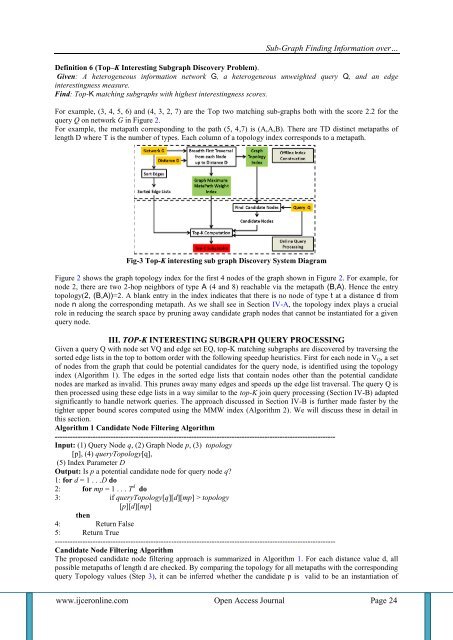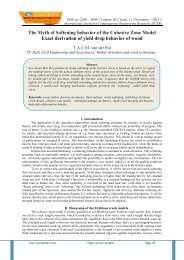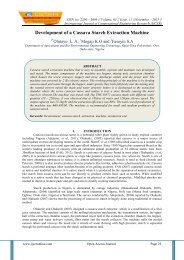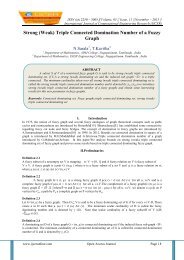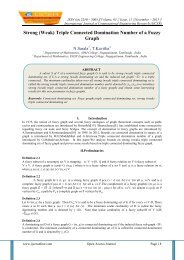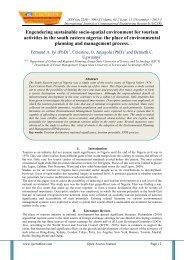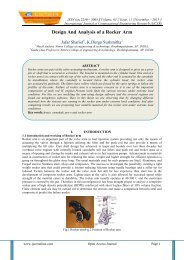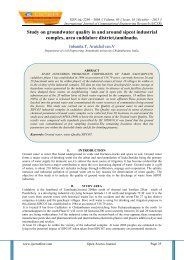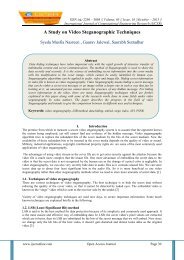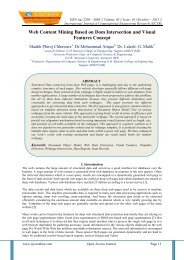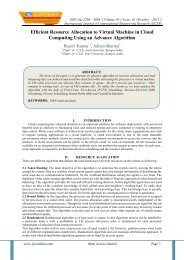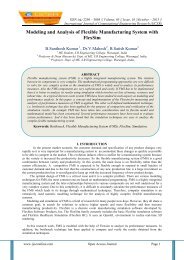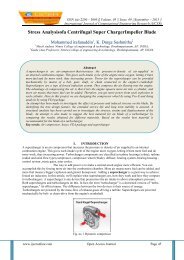You also want an ePaper? Increase the reach of your titles
YUMPU automatically turns print PDFs into web optimized ePapers that Google loves.
Sub-Graph Finding Information over…<br />
Definition 6 (Top–K Interesting Subgraph Discovery Problem).<br />
Given: A heterogeneous information network G, a heterogeneous unweighted query Q, and an edge<br />
interestingness measure.<br />
Find: Top-K matching subgraphs with highest interestingness scores.<br />
For example, (3, 4, 5, 6) and (4, 3, 2, 7) are the Top two matching sub-graphs both with the score 2.2 for the<br />
query Q on network G in Figure 2.<br />
For example, the metapath corresponding to the path (5, 4,7) is (A,A,B). There are TD distinct metapaths of<br />
length D where T is the number of types. Each column of a topology index corresponds to a metapath.<br />
Fig-3 Top-K interesting sub graph Discovery System Diagram<br />
Figure 2 shows the graph topology index for the first 4 nodes of the graph shown in Figure 2. For example, for<br />
node 2, there are two 2-hop neighbors of type A (4 and 8) reachable via the metapath (B,A). Hence the entry<br />
topology(2, (B,A))=2. A blank entry in the index indicates that there is no node of type t at a distance d from<br />
node n along the corresponding metapath. As we shall see in Section IV-A, the topology index plays a crucial<br />
role in reducing the search space by pruning away candidate graph nodes that cannot be instantiated for a given<br />
query node.<br />
III. TOP-K INTERESTING SUBGRAPH QUERY PROCESSING<br />
Given a query Q with node set VQ and edge set EQ, top-K matching subgraphs are discovered by traversing the<br />
sorted edge lists in the top to bottom order with the following speedup heuristics. First for each node in V Q , a set<br />
of nodes from the graph that could be potential candidates for the query node, is identified using the topology<br />
index (Algorithm 1). The edges in the sorted edge lists that contain nodes other than the potential candidate<br />
nodes are marked as invalid. This prunes away many edges and speeds up the edge list traversal. The query Q is<br />
then processed using these edge lists in a way similar to the top-K join query processing (Section IV-B) adapted<br />
significantly to handle network queries. The approach discussed in Section IV-B is further made faster by the<br />
tighter upper bound scores computed using the MMW index (Algorithm 2). We will discuss these in detail in<br />
this section.<br />
Algorithm 1 Candidate Node Filtering Algorithm<br />
---------------------------------------------------------------------------------------------------------------<br />
Input: (1) Query Node q, (2) Graph Node p, (3) topology<br />
[p], (4) queryTopology[q],<br />
(5) Index Parameter D<br />
Output: Is p a potential candidate node for query node q?<br />
1: for d = 1 . . .D do<br />
2: for mp = 1 . . . T d do<br />
3: if queryTopology[q][d][mp] > topology<br />
[p][d][mp]<br />
then<br />
4: Return False<br />
5: Return True<br />
---------------------------------------------------------------------------------------------------------------<br />
Candidate Node Filtering Algorithm<br />
The proposed candidate node filtering approach is summarized in Algorithm 1. For each distance value d, all<br />
possible metapaths of length d are checked. By comparing the topology for all metapaths with the corresponding<br />
query Topology values (Step 3), it can be inferred whether the candidate p is valid to be an instantiation of<br />
www.ijceronline.com Open Access Journal Page 24


